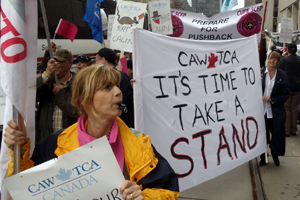Relearning Solidarity in the Air Canada Strike

Few industries have experienced more turbulence than the airline industry in Canada.
Since deregulation in the late 1980s, workers in this industry have undergone waves of layoffs and concessions, with every airline either undergoing major restructuring due to bankruptcy or ceasing operations entirely.
This turmoil has taken its toll on Air Canada's 3,800 customer sales and service workers, who work in airports and call centers across the country and are represented by the Canadian Auto Workers. They have survived from one crisis to another by sacrificing hard-won gains.
When management brought a new wave of concessions to the bargaining table earlier this year, the last thing they expected was a defiant reaction from these beaten-down workers. Their last strike was in 1985.
But the anger was palpable, and record numbers of workers voted 98 percent in favor of strike action. When the strike was called, the mood was one of celebration, with not one member crossing the lines.
This empowerment did not occur in isolation. When the company demanded concessions including a 40 percent cut in pensions for current members, complete loss of defined-benefit pensions for future workers, and contracting out of work affecting around 50 percent of the membership, the local started a quiet organizing campaign to change its membership’s culture.
Inside committees were formed to plan rallies in each region of the country, conduct educational events, and train flying squads—mobile pickets that bolster a strike—to help carry out the actions. On the strike’s second day, CAW members launched an occupation of the Minister of Labour‘s office.
This campaign not only built confidence and an activist corps but allowed them to develop the skills required to run an effective strike. Most importantly, it allowed them to finally express their anger at working for a corporation that has come to symbolize corporate excess.
In 2010 Air Canada's CEO received a 75 percent pay increase, adding to a legacy of gross executive payouts. A previous CEO received more than $53 million in wages and bonuses after workers gave up $40 million in concessions in 2004 to “save the company.”
Back-to Work Legislation
The energy that workers took to their picket lines took many by surprise.
Within 13 hours, the Canadian government was hastily drafting back-to-work legislation to protect their friends in Air Canada's boardroom.
At the same time, other unions and community groups started mobilizing in support. Other unionized Air Canada workers participated in on-the-job actions of solidarity, including Machinists who took “CAW breaks” and refused to cross picket lines.
Public opinion started turning against the government and Air Canada management, who on one hand were stating that it was “business as usual” and, on the other, stating that the strike’s disruptions could undermine Canada’s entire economy.

SUPPORT LABOR NOTES
BECOME A MONTHLY DONOR
Give $10 a month or more and get our "Fight the Boss, Build the Union" T-shirt.
Meanwhile, the Postal Workers began their rolling strikes at Canada Post over a two-tier plan, prompting management to lock them out and government to announce it was also preparing back to work legislation against them.
In both cases the issue was the same: the government will take whatever action is required to ensure future generations of Canadian workers will not have defined-benefit pensions and will work in precarious jobs paying barely above the minimum wage.
For many of these workers, the government intervention was a revelation. Many were Conservative supporters who had never thought they were the “overpaid, lazy workers” the Conservatives and corporate media complain about. The government they supported was preparing to take legal action against anyone who refused the impending back-to-work legislation.
What Security?
Even more startling was the willingness to toss out security procedures. An agreement to waive these regulations between the U.S. and Canadian governments allowed Air Canada to continue operations with untrained management and scab labor.
The growing support for the workers put pressure at the table. By the strike’s third day, a tentative agreement was reached, with some key gains that reversed years of concessions in working conditions. Paid meal breaks returned, along with better scheduling language.
But the biggest issue—the pensions of future workers—is still undecided and will proceed to arbitration.
Was an opportunity lost to create a “Wisconsin moment”? Perhaps, but what matters is that the strike showed it is still possible to mobilize workers through education and grassroots organizing.
Progress is visible. Less than a week after the strike ended, Air Canada members in Toronto organized a rally to support the locked-out postal workers. Any sort of membership-led act of solidarity like this would have been unthinkable only a few months ago.
Networks are expanding, too: activists from five unions took part in this event. They are already planning to mobilize for other unionized airline groups, which all face the same takeaway agenda at their bargaining tables.
Since the government and CEOs have made it abundantly clear that the old rules of collective bargaining no longer have any meaning, it’s critical that these capacities be developed now instead of waiting for the next attack.
Sean Smith is a community-based organizer who was CAW Local 2002's strike coordinator during the Air Canada dispute. He is also a member of the Greater Toronto Workers' Assembly.
